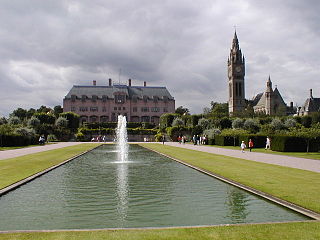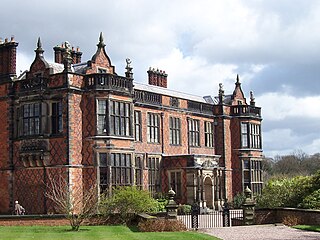
Lyme Park is a large estate south of Disley, Cheshire, England, managed by the National Trust and consisting of a mansion house surrounded by formal gardens and a deer park in the Peak District National Park. The house is the largest in Cheshire, and is recorded in the National Heritage List for England as a designated Grade I listed building.

Eaton Hall is the country house of the Duke of Westminster. It is 1 mile (2 km) south of the village of Eccleston, in Cheshire, England. The house is surrounded by its own formal gardens, parkland, farmland and woodland. The estate covers about 10,872 acres (4,400 ha).

Capesthorne Hall is a country house near the village of Siddington, Cheshire, England. The house and its private chapel were built in the early 18th century, replacing an earlier hall and chapel nearby. They were built to Neoclassical designs by William Smith and (probably) his son Francis. Later in the 18th century, the house was extended by the addition of an orangery and a drawing room. In the 1830s the house was remodelled by Edward Blore; the work included the addition of an extension and a frontage in Jacobean style, and joining the central block to the service wings. In about 1837 the orangery was replaced by a large conservatory designed by Joseph Paxton. In 1861 the main part of the house was virtually destroyed by fire. It was rebuilt by Anthony Salvin, who generally followed Blore's designs but made modifications to the front, rebuilt the back of the house in Jacobean style, and altered the interior. There were further alterations later in the 19th century, including remodelling of the Saloon. During the Second World War the hall was used by the Red Cross, but subsequent deterioration prompted a restoration.

Arley Hall is a country house in the village of Arley, Cheshire, England, about 4 miles (6 km) south of Lymm and 5 miles (8 km) north of Northwich. It is home to the owner, Viscount Ashbrook, and his family. The house is a Grade II* listed building, as is its adjacent chapel. Formal gardens to the southwest of the hall are also listed as Grade II* on the National Register of Historic Parks and Gardens. In the grounds are more listed buildings, a cruck barn being listed as Grade I, and the other buildings as Grade II.

Adlington Hall is a country house near Adlington, Cheshire. The oldest part of the existing building, the Great Hall, was constructed between 1480 and 1505; the east wing was added in 1581. The Legh family has lived in the hall and in previous buildings on the same site since the early 14th century. After the house was occupied by Parliamentary forces during the Civil War, changes were made to the north wing, including encasing the Great Hall in brick, inserting windows, and installing an organ in the Great Hall. In the 18th century the house was inherited by Charles Legh who organised a series of major changes. These included building a new west wing, which incorporated a ballroom, and a south wing with a large portico. It is possible that Charles Legh himself was the architect for these additions. He also played a large part in planning and designing the gardens, woodland and parkland, which included a number of buildings of various types, including a bridge known as the Chinese Bridge that carried a summerhouse.

St Wilfrid's Church stands to the north of the village of Mobberley, Cheshire, England. The church is recorded in the National Heritage List for England as a designated Grade I listed building. It is an active Anglican parish church in the diocese of Chester, the archdeaconry of Macclesfield and the deanery of Knutsford. Alec Clifton-Taylor includes it in his list of 'best' English parish churches.

Ashley Hall is a country house standing to the north of the village of Ashley, Cheshire, England. It dates from the late 16th to the early 17th century, with additions made in the 18th and 19th centuries. The house is historically important because it was here that the Cheshire gentlemen met in 1715 to decide whether to support the Stuarts or the Hanoverians. They decided on the latter and later commissioned a set of portraits, which now hang in Tatton Hall. The house is recorded in the National Heritage List for England as a designated Grade II listed building. Also listed at Grade II are the gate piers to the forecourt of the building, a carriage house in the forecourt, the kitchen garden wall, and the stable block. For the 2019 biopic Tolkien, 15 acres of the Tatton Estate were used to recreate the trenches of the First World War.

Calveley Hall is a country house to the west of the village of Milton Green, Cheshire, England. It was built in 1684 for Lady Mary Calveley. After Lady Mary's death the estate passed by marriage to the Leghs of Lyme. In 1818 it was remodelled for Thomas Legh, and further alterations have been carried out during the 20th century.

Checkley Hall is a small country house in the parish of Doddington and District, in Cheshire, England. The house was built in 1694 by the Delves family of Doddington, replacing an earlier timber-framed house. It was altered in the late 18th or early 19th century, replacing a hipped roof with an attic. The house is constructed in brick with a tiled roof. It has 2½ storeys, and an entrance front with five bays. The house is recorded in the National Heritage List for England as a designated Grade II* listed building. Its gate piers are listed at Grade II.
Christleton Old Hall is a former country house in the village of Christleton, Cheshire, England.

Crag Hall is a country house east of the village of Wildboarclough, Cheshire, England and owned by the Earl of Derby.

Dukenfield Hall is a country house between Knutsford and Mobberley in Cheshire, England.

The Old Hall is a country house in the village of Mobberley, Cheshire, England. It was built in 1612 and extended later in the 17th century. The house stands in gardens which retain part of the moat and ancient yew trees. The house is recorded in the National Heritage List for England as a designated Grade II* listed building, and the grounds contain two Grade II listed buildings.
Newton Hall is a country house east of the village of Mobberley, Cheshire, England. It was built between 1634 and 1676 for Francis Newton. Additions were made to the house in the 19th and 20th centuries. It is constructed in brick that has been rendered and whitewashed, and has stone dressings and slated roofs. The house has three storeys, and along the entrance front are three gables with bargeboards dating from the 19th century. In the ground floor are five windows, all in 20th-century metal frames. In the upper floors are 19th-century two-light casement windows. To the left of the house is a large 20th-century extension, and behind it is a wing dating from the 17th century. The house is recorded in the National Heritage List for England as a designated Grade II listed building. The gate piers, dating from the 18th century, are also listed at Grade II.

Ramsdell Hall is a country house in the parish of Odd Rode in Cheshire, England, overlooking the Macclesfield Canal. It was built in two phases during the 18th century, and is still in private ownership.

Shotwick Hall is a former manor house in the village of Shotwick, Cheshire, England. It replaced an earlier manor house that stood on a moated site some 150 metres to the west. The hall and four associated structures are listed buildings, and the moated site is a Scheduled Monument.

Tattenhall Hall is a country house standing to the south of the village of Tattenhall, Cheshire, England. The house is designated by English Heritage as a Grade II* listed building.

Saltersley Hall is a country house about 2 miles (3.2 km) west of Wilmslow, Cheshire, England, in the civil parish of Mobberley. The authors of the Buildings of England series describe it as a "lonely but high-status ... house on a sand island in the middle of Lindow Moss". The house was built in the 17th century, with additions in the 19th and 20th centuries. It is constructed in sandstone and whitewashed brick with a slate roof. Its medieval H-shape has been rationalised to form a flat front with three gables. The windows are mullioned. The house is recorded in the National Heritage List for England as a designated Grade II listed building.
Mobberley is a civil parish in Cheshire East, England. It contains 43 buildings that are recorded in the National Heritage List for England as designated listed buildings. Of these, one is listed at Grade I, the highest grade, three are listed at Grade II*, the middle grade, and the others are at Grade II. Other than the village of Mobberley, and part of the runways of Manchester Airport, the parish is rural. The listed buildings are what would be expected in such an area, namely country houses and associated structures, farmhouses and farm buildings, smaller houses and cottages, and a church with associated structures.

Thurstaston Hall is a country house in the village of Thurstaston, Wirral, Merseyside, England. The house is built in stone and brick, it is in two storeys, and it has a U-shaped plan. The oldest part, the west wing, was built in the 14th century, the central block dates from 1680, and the east wing was added in 1836. The hall is recorded in the National Heritage List for England as a designated Grade II* listed building, and the gate piers in the drive leading to the hall are designated Grade II.


















